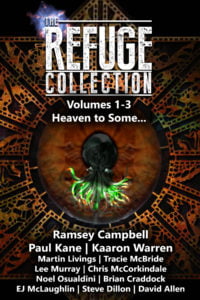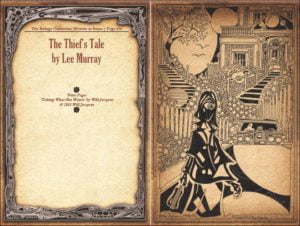It’s a funny world, and I don’t mean ha-ha funny, but epic-small funny. Stephen Dillon crossed my radar as a radical giver-of-time-for-stuff-bigger-than-himself by way of us both knowing Lee Murray. He’s the brains – and, let’s be honest, pretty much the muscle too – behind The Refuge Collection. Besides being an excellent collection of genre fiction set around a mythical town called Refuge, it’s a project that’s attracted a great many authors and artists to his banner to help out charity.
Before we hit the pimp my ride part of the show, let’s do some quiet introductions…
 First up, tell us a little about how you got into this publishing-for-charity gig. Did you approach it as a writer, or from a different angle? Where did the idea come from?
First up, tell us a little about how you got into this publishing-for-charity gig. Did you approach it as a writer, or from a different angle? Where did the idea come from?
I was writing a bunch of stories at the same time, which is sometimes how it happens, right? Then I decided it would be great if these all came together in a shared-world setting and the characters could interact, and the stories influence each other’s writing. I happened to catch some TV coverage of the worldwide refugee crisis while I was in the UK on extended care leave, so I was instantly compelled to make this into a charity gig in response to what I saw. The next obvious thing (to me) was to engage some of my writing buddies and leverage my social networks to see if others would be interested in helping out. Wonderful man that he is, Ramsey Campbell was the first person I approached, and he generously offered to support the project and granted me permission to not only reprint one of his stories, but to adapt it to fit into the shared-world setting of Refuge. After that, things just snowballed and I realised a lot of great writers were looking for a project just like this. Actually, Lee Murray, who you mentioned, was one of the first writers to get her passport stamped at Refuge.
Do you have a favourite author or authors? Favourite movie? Cartoon?
Wow, these are tough questions to answer without writing a book… but of course Ramsey Campbell is one, Clive Barker another, Tolkien, Lovecraft, Pratchett, Brian Lumley, MR James, and many of my writer friends who are now legion. Of course I love all the stories in The Refuge Collection, and by implication, all of the writers. My favourite movie is probably Jason & the Argonauts, and I was an avid fan of all things Ray Harryhausen as a kid. Favourite cartoon must be The Simpsons; there is just so much intelligence and humour in a lot of those episodes. It’s worth watching the bad ones just to get to the great ones.
You’re trapped in Refuge – you, *the* Stephen Dillon. Who’s with you, and what do you do next?
Arrrghhhh…. I’d hope to have my wife Jackie with me because Jackie would ground me. I’d probably look for a way to escape or hike up into the mountains and hide until after the big one has happened.
Best, “Hold my beer and watch this,” story..?
You’ve got me stumped. I’ve never let anyone else hold my beer…
 Now, The Refuge Collection: Do you think that being the series editor for The Refuge Collection has helped your own writing? Not just in terms of better words on a page, but in terms of the ambition in your work? Can you tell us which of your works has been most influenced by your journey with The Refuge Collection?
Now, The Refuge Collection: Do you think that being the series editor for The Refuge Collection has helped your own writing? Not just in terms of better words on a page, but in terms of the ambition in your work? Can you tell us which of your works has been most influenced by your journey with The Refuge Collection?
Undoubtedly the greatest help has been collaborating with the other writers. I’ve received excellent feedback and suggestions from ‘first readers and proofers,’ and I’ve learned a lot technically as well as emotionally about the art and the science of writing. I think of Lee Murray and Noel Osualdini as my ‘right brain/left brain’ reviewers. I hope that doesn’t come across as patronising or anything, and others have supported me throughout in my journey with The Refuge Collection, but they’re my ‘go to’ editors for my own stories. It’s also been great to be able to read other writers’ first drafts and help them develop their story by integrating it with Refuge. The greatest challenge for me in terms of writing was a short story called ‘Next Door’s Noisy’ – it’s a very sad tale in many ways, and I tried to back down from writing it, but I was pretty much told to pull up my big-boy shorts and stretch. I’d never written a love story before, and yet here I was attempting to write the purest love story I could imagine, about two little children. I wept as I wrote it, and I still cry when I read it, and I know at some point soon I have to narrate it for the audio book. I will probably cry again.
I can see from the charities you focus on there’s a bit of a theme. Is that deliberate? Is it a sign of the things you want to promote in society?
Well the refugee crisis spurred the books, so the main beneficiaries have been Sanctuary Australia Foundation (SAF) and Refugee Action UK. I’m working most closely with SAF, but they both have similar goals, to help refugees settle in their respective country.
Do you think your writers share this? Or to put it another way, do you look for writers who share a common vision? If someone wants to help out, what are the things you’re hoping to find out there?
From the start, I asked all the writers and artists – every story has an accompanying illustration that we used as the cover for the individual ebooks, and included in the printed books – if they were happy for the proceeds to go to the chosen charities, or to choose a separate charity, and they all agreed. Nobody has made any money from these books except for the charities, who have clearly put it to good use. We know for example the money given to SAF paid the bulk of the flight to Australia for a refugee family from Syria to be reunited here in Australia, and that’s what the book is all about. I see this as a way for us to do something we’re passionate about, for a great cause. “Fictional horror stories supporting people living real-world horror stories” I’m hoping people continue to support these charities specifically and be supportive of the refugee crisis generally. Also, my hope is that reading some of the stories might help readers gain valuable insights into its underlying themes – displacement, isolation, abandonment, bigotry, abuse – and also how governments need to respond better to these issues.
 Projects of any size and scale tend to rely on skills with networking – and also build lasting friendships. Do you think the project has helped people in the writing community forge better bonds? Did people come out of hiding to chip in that surprised you? Thinking about the range of diversity as an asset, what did those people bring to the table? I guess where I’m going is that when I hold a book in my hand, an anthology made by 300+ people, it’s not obvious how difficult it is to make that happen. Who we rely on, and why.
Projects of any size and scale tend to rely on skills with networking – and also build lasting friendships. Do you think the project has helped people in the writing community forge better bonds? Did people come out of hiding to chip in that surprised you? Thinking about the range of diversity as an asset, what did those people bring to the table? I guess where I’m going is that when I hold a book in my hand, an anthology made by 300+ people, it’s not obvious how difficult it is to make that happen. Who we rely on, and why.
It has taken a lot of networking, and some of the contributors are very engaged with each other and with the project. I’d like to think long-lasting friendships and professional relationships have been formed, and new bonds have certainly been made from my perspective. I actively sought diversity across different nationalities, cultural differences, and I think there is some universality in the flavours and themes we’ve explored in Refuge. Not quite as much as I’d like to have seen, but it was certainly a goal at the outset. That reflects more my networking boundaries and the reach of my social networking rather than any unwillingness to contribute on the part of any individual or cultural group. Refuge is all about equality and inclusivity, which sounds gauche when you read it on this page, but is evident throughout the storylines.
If you wanted to provide advice to someone who wanted to follow in your footsteps – make their own anthology, for example – what would you tell them?
It’s taken me almost year to get to the point where the second printed book is almost ready to go, so plan for that. I could easily have written 36 stories in half that time, but that would have been less fulfilling and probably had less of an impact. Also, specifically in a shared-world setting, it’s great fun, but a lot harder than I ever imagined. A few of us started developing the Refuge Companion, which I hope we can complete next year. This provides breakdowns of characters, timeline for key events, as well as Easter eggs, symbolism, secret stories, plot summaries, etc. Refuge is still growing and I hope to see another anthology, maybe next year, or in a decade from now, perhaps with someone else at the helm, but who knows?
Tell me a little about the marketing side of things. I think this is non-obvious for many writers, especially indie ones: you need to make lightning strike. The Refuge has audiobooks out, you’ve done marketing/publicity, and coach other writers on what it takes to be successful in the anthology. Can you describe your journey here, what keeps you going when it gets hard, and what it might have made you have to put aside to make it happen?
Quite simply, I wish I was better at marketing, because more people need to buy the books, because the charities need more money so they can help more people. I think Refuge is still a distant thunder, but I hope the lightning will strike one day, perhaps in the form of a TV series, which has always been on the back of my mind.
From a narrative point of view, how do you keep all the stories in the anthologies together? I know trying to keep my own writing straight is tricky enough, and there’s just me to consider there. Do you give people a brief, or meet with them, or what? How does the magic trick work?
It’s all been done by email and Facebook, and spreadsheets… and lots of read-edit-review-edit cycles. Typically I ask for a first draft or story overview early on, so I can give feedback or make suggestions like “Hey, can this character of yours have a job at the herring cannery, because that works well with this other story”. Sometimes it’s been a case of going back to a writer and asking “Do you mind if we re-use your character because this new story needs someone who can…” etc. The hardest part for me has been sequencing, because if one writer wants to kill off a character that another story relies on, you have to wait until story B has been published before you can publish story A… The other hard part has been where writers have really wanted to include X or Y, but it just doesn’t fit with another story, or upsets the interior consistency of Refuge, or doesn’t support the underlying themes in support of refugees. I’ve had to reject a couple of pieces after a significant effort on the part of myself and the writer, and they were very tough calls to make.
We’re getting towards the end … can you tell us what’s next on the agenda?
I have a roadmap in my head. Book Two, ‘The Refuge Collection, Hell to Others’ isn’t complete yet (there are six stories to publish!) and the audio books have started, but we have a long way to go. Then there is the Companion, then hopefully the screenplays (hopefully a TV series!) and maybe even graphic novels one day. I’m hoping longer-term that other writers might pick up on Refuge and start adding to the collection, and I fully support that providing the intention is to raise money for charities. But reader-demand and marketing are huge factors in the success of this roadmap, as are my own energy levels. I have zero budget and nobody makes a profit on this, remember, so getting somebody to turn up with some investment money would be like a win on the lotto for The Refuge Collection and the charities we support.
And may I offer my thanks to you for allowing me this airspace and to your readers for getting this far. Thanks.
- www.RefugeCollection.com
- Facebook: /refugecollection
- Twitter: @Refuge
- Author Page: http://amzn.to/2bSoxlz
- Smashwords: https://www.smashwords.com/books/byseries/22669
- Author Bio: http://refugecollection.com/the-team/steve-dillon-bio/
— Steve Dillon, series editor of The Refuge Collection – dillonstephen@hotmail.com
Discover more from Parrydox
Subscribe to get the latest posts sent to your email.